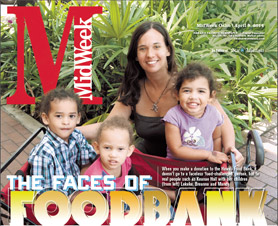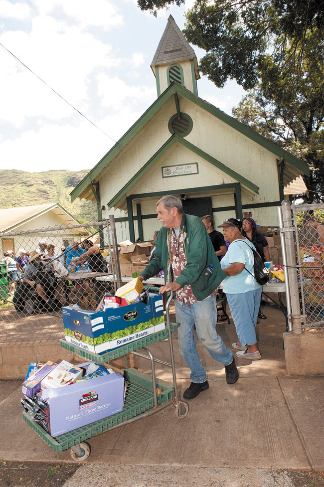The Faces Of Foodbank
This is a story about the Hawaii Foodbank, but even more it is a story about people – those who work or volunteer there, as well as those who benefit from your donations.
There’s a bank in town where deposits and withdrawals are saving lives.
There are no loans or mortgages involved in its transactions, yet there is compounded interest in humanity every day.
mw-cover-040914-foodbank-2
We’re speaking of Hawaii Foodbank. In its 25th year of operation, it is a pillar of our community.
Ka-ching. Cash in on compassion.
You don’t need a financial statement to know the score in Hawaii. Hawaii Foodbank distributes more than 11.8 million pounds of food, including 2.6 million pounds of fresh produce annually – or nearly 9.4 million meals to needy children, seniors and families in our community.
By doing so, it fulfills a heartfelt mission that no one in our state goes hungry.
We probably don’t need to tug at your heartstrings to tell the Hawaii Foodbank story. Each year about this time, you go to your cupboards to generously share your goods with those less fortunate in our community. Spam, pork and beans, soup, vegetables, household cleaning items and even paper products are assembled for collection.
You also dip into your wallets and checkbooks to make monetary donations. A $10 donation, for instance, translates into food for 25 meals. Considering grocery prices these days, that’s a significant return on investment.
The money raised in Hawaii stays in Hawaii. In fact, 94 cents of every dollar goes directly to feeding the hungry. Hawaii Foodbank has one of the highest ratings in the nation for charitable financial performance, accountability and transparency.
Trouble is, most of us only see the depository and rarely follow our investment (donation) through the distribution system.
Spamalot
Where does a can of Spam, for instance, go once you place it in a collection bin? Does it go directly onto the plate of a hungry person or institutional feeding?
“Well, yes, eventually it does get there. But like products in a wholesale warehouse, there are a few more stops along the way before reaching consumers,” says Lori Kaya, Hawaii Foodbank grants and communications manager.
A visit to Hawaii Foodbank headquarters at 2611 Kilihau Street in Mapunapuna shows us how donations are carefully sorted, inspected and prepared for distribution to 250 member agencies that are consumer outlets.
Behind the scenes at Hawaii Foodbank is a fascinating facet of its amazing operation. If there is a heartbeat to the daily operations, it could be the sound of trucks backing up to its loading docks to bring in and deliver bulk donations from retailers, food manufacturers and farmers.
Beep, beep, beep. It hasn’t missed a beat for 25 years.
There are three main sections at the 23,500-square-foot food bank facility. One section stores cases of packaged goods donated by retailers and wholesalers who have overstock in their inventory. Each pallet is clearly marked with source, dates, contents and weight for expeditious handling. A record is kept of all bulk donations for tax credit purposes.
Transparency, right?
Cool Customer
A produce and fresh food section, equipped with a huge chiller and refrigerated unit, keeps vegetables, perishables and baked goods. Staff and volunteers carefully inspect each item to meet stringent safety guidelines for redistribution to consumers. If it does-n’t pass inspection, it is dumped.
The same goes for the canned and packaged goods area, known as the salvage room, where trained volunteers sort and inspect every can and package that comes to the food bank.
“Cans must have a label. If the container has any rust, dents, punctures or marks that compromise the integrity of the product, it is rejected on the spot,” Kaya explains.
In an ongoing sorting and inspection process, products are categorized and placed in bins for easy retrieval by agencies that routinely pick up food supplies from the food bank.
Each agency sets an appointment to do its grocery shopping at the food bank. Each collection is weighed and documented so there is a log of who gets what and when.
Accurate accountability, remember?
A visionary samaritan named John White founded Hawaii Foodbank in May 1983 with one driver and a modest warehouse at Sand Island. His first food drive in 1989 brought in 25,000 pounds of food and $5,500 in cash donations.
Today the food bank handles 500 times the amount of food and 700 times the amount of money. Not only has the state population grown over the years, but the awareness of this cause has reached more audiences, thanks to media exposure.
Pioneering television coverage was former KGMB-TV news director Terry Heaton, who coupled community-mindedness with the station’s slogan, “One of good things about Hawaii.”
Heaton, who is in Honolulu this month to help promote the food drive, recalls, “I thought this would be a good way to showcase not only the slogan, but also the people behind it. News people are always bathed in the inhumanity that surrounds us. This kind of event gives us an opportunity to actually be a blessing. And Hawaii, with its emphasis on family, certainly is deserving of such an effort.”
A media consultant and writer, Heaton now is based in Texas, where he works with AR&D and helps clients with changing communications models. Heaton’s boss and station general manager at KGMB was Dick Grimm, who today is chief executive officer of Hawaii Foodbank and served as its president since 2000.
Should be quite reunion as the two media mavericks steer the course for this year’s food drive that culminates Saturday, April 19.
Head Cheerleader
Someone who also knows the ropes of a community-wide drive is Sherri Rolf of Rolf Advertising, who has been campaign chairwoman for the past 24 years.
“Our agency does promotions for shopping centers, and years ago I was approached about helping the Hawaii Foodbank take its message to the community,” she explains. “From one collection point at Restaurant Row (now Waterfront Plaza) we have grown to eight food drop sites.
“Our goal this year is to collect enough food and money for one million meals. My personal goal is to reach 2 million.”
Considering the shortage in inventory the food bank has been experiencing lately, over-reaching is a good strategy to ensure the cupboards are not bare at critical times.
Rolf acknowledges that the level of collection reflects the scarcity of commodities in general as well as the competition for causes. Donors are responding to a number crisis appeals, such as Typhoon Haiyan in the Philippines.
There are other barriers as well, according to Polly Kauahi, Hawaii Foodbank chief operating officer.
“Many think individuals struggling with hunger are homeless and out of work,” she says. “While our member agencies do serve that sector with their faith-based or grassroots programs, that is not entirely true.”
She feeds us the facts:
* In 2010, only 10 percent of clients served by food banks nationally were homeless, and 36 percent of households had at least one working adult. In Hawaii, 42 percent of households include at least one employed adult, like Keanae Hall, mother of three tots whose husband Lester works as a tour bus driver (pictured on cover).
* About 30 percent of the households served by Hawaii Foodbank are children under 18 years of age. Some 11,000 seniors in Hawaii need emergency food assistance each year.
* Nineteen percent of food bank clients choose between paying for food and paying for medicine or medical care, according to the 2010 Hunger in America report for Hawaii. Michael McClain of Waianae-Nanakuli, a disabled veteran of two deployments and a Hawaii Foodbank volunteer, can attest to that.
* About 35 million tons of food waste reaches landfills and incinerators each year in the U.S., according to the U.S. Environmental Protection Agency.
That last point might be the clincher for this year’s reason to give.
Feed people, not landfills.
Hawaii Foodbank Food Drive is Saturday, April 19, 8 a.m. to 3 p.m. at Waterfront Plaza, Koko Marina Center, McCully Shopping Center, Pearl City Shopping Center, Town Center of Mililani, Waiokeola Congregational Church in Kahala, Windward City Shopping Center and Kapolei Commons.







